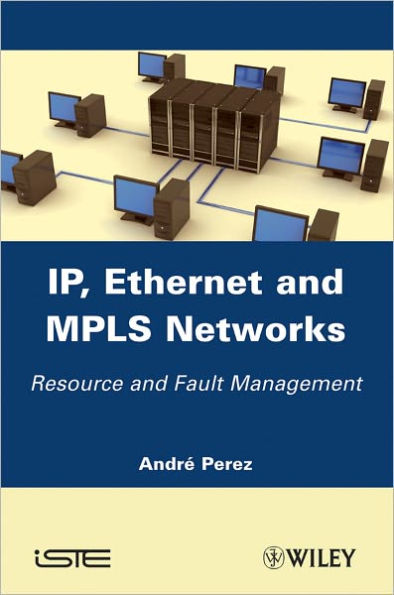Table of Contents
Preface xi
Chapter 1 Network Operation 1
1.1 Basic concepts 1
1.1.1 Layered structure 1
1.1.2 LANs 3
1.1.3 WANs networks 5
1.1.4 Protocol architecture 6
1.1.5 Addressing principles 8
1.2 IP technology 9
1.2.1 Routing 9
1.1.2 The IPv4 protocol 10
1.1.3 The IPv6 protocol 12
1.3 The MPLS technology 14
1.3.1 Label switching 14
1.3.2 Tables in the LSR 15
1.3.3 The PHP function 16
1.3.4 The format of the MPLS header 16
1.3.5 Encapsulation of a labeled packet 18
1.4 The ICMP 19
1.5 Ethernet technology 22
1.5.1 The physical layer 22
1.5.2 The data link layer 24
Chapter 2 Characterizing Quality of Service 27
2.1 Quality of service functions 27
2.2 Quality of network operation 269
2.2.1 Availability 29
2.2.2 Admissibility 32
2.2.3 Loss ratio 33
2.2.4 Delay 34
2.2.5 Jitter 34
2.2.6 Classes of service 34
2.2.7 Bandwidth 35
2.3 Requirements of applications 36
2.3.1 Voice 36
2.3.2 Video 41
2.3.3 Application and control data 43
2.4 The service contract 44
2.4.1 The "Enterprise" section 46
2.4.2 The "Service" section 47
2.4.3 The "Technology" section 48
2.4.4 The Quality of Service report 50
Chapter 3 Transport Protocols 51
3.1 Introduction 51
3.2 The TCP 52
3.2.1 Format of the TCP header 52
3.2.2 Initiating and closing a connection 54
3.2.3 Data transfer 55
3.2.4 The slow start and congestion avoidance mechanisms 56
3.2.5 The fast retransmit and fast recovery mechanisms 57
3.2.6 The ECN mechanism 58
3.3 The UDP 59
3.3.1 Format of the UDP header 60
3.4 The RTP 60
3.4.1 Format of the RTP header 61
3.5 The RTCP 62
3.5.1 Format of the SR message 63
3.5.2 Format of the RR message 65
3.6 The DCCP 65
3.6.1 DCCP procedure 66
3.6.2 Congestion control 67
3.6.3 Format of the DCCP header 67
3.6.4 Options 69
3.7 The SCTP 70
3.7.1 Format of the SCTP header 71
3.7.2 Association 72
3.7.3 Data transfer 73
Chapter 4 Implementing Operation Quality 77
4.1 The architectural framework 77
4.2 Implementation of resource management 77
4.2.1 Relative QoS 78
4.2.2 Guaranteed QoS 79
4.2.3 Resource reservation scenarios 80
4.2.4 Mechanisms associated with the user plane 83
4.2.5 Load balancing 92
4.2.6 Link optimization mechanisms 92
4.3 Implementing fault management 96
4.3.1 Network reconfiguration 96
4.3.2 Fault detection 97
4.3.3 Equipment reconfiguration 98
Chapter 5 IP Technology - Resource Management 101
5.1 Introduction 101
5.2 The DiffServ model 102
5.2.1 The DSCP field 102
5.2.2 The DiffServ architecture 106
5.3 The IntServ model 109
5.3.1 Principles of resource reservation 109
5.3.2 The RSVP 110
5.4 The ARSVP protocol 123
5.4.1 Principles of aggregation 123
5.4.2 The ARSVP procedure 124
Chapter 6 IP Technology - Fault Management 127
6.1 Introduction 127
6.2 Hot Standby Router Protocol 128
6.2.1 Operating principles 128
6.2.2 Format of the HSRP message 129
6.2.3 Load balancing 131
6.3 Virtual Router Redundancy Protocol 132
6.3.1 Operating principles 132
6.3.2 Format of the VRRP message 132
6.4 OSPF protocol 134
6.4.1 Operating principles 134
6.4.2 Format of the OSPF message 134
6.4.3 Restarting the OSPF protocol 139
6.5 Border Gateway Protocol 144
6.5.1 Operating principles 144
6.5.2 Format of the BGP message 145
6.5.3 Path attributes 147
6.5.4 Route selection 148
6.5.5 BGP restart 149
Chapter 7 MPLS Technology - Resource Management 153
7.1 Introduction 153
7.2 Support for DiffServ 154
7.2.1 Types of virtual circuits 154
7.2.2 Interaction between markings 156
7.3 Traffic engineering 158
7.3.1 Operating principles 158
7.3.2 The RSVP - TE protocol 160
|7.3.3 OSPF - TE protocol 174
Chapter 8 MPLS Technology - Fault Management 177
8.1 Introduction 177
8.2 The LDP 178
8.2.1 Operating principles 178
8.2.2 Format of the LDP PDU 180
8.2.3 The LDP messages 182
8.2.4 Restarting the LDP 185
8.3 The RSVP -TE protocol 189
8.3.1 Failure detection 189
8.3.2 Restarting the RSVP - protocol 190
8.4 The FRR mechanism 193
8.4.1 Operating principles 193
8.4.2 Extensions of the RSVP - TE protocol 195
8.4.3 Procedure of the FRR mechanism 199
Chapter 9 Ethernet Technology - Resource Management 203
9.1 Introduction 203
9.2 Priority management 204
9.3 Resource reservation 207
9.3.1 The bandwidth manager 207
9.3.2 The SBM protocol 209
9.4 Flow control 216
9.5 The access network 217
9.5.1 Architecture of the PON 218
9.5.2 Priority management in EPON 220
9.5.3 Priority management in GPON 221
9.6 The aggregation network 224
Chapter 10 Ethernet Technology - Fault Management 227
10.1 Introduction 227
10.2 The STP 228
10.2.1 Operating principles 228
10.2.2 Format of the BPDU message 229
10.2.3 Procedure of the STP 231
10.3 The RSTP 233
10.3.1 Operating principles 233
10.3.2 Format of the BPDU message 234
10.3.3 Procedure of the RSTP 234
10.4 The MSTP 235
10.4.1 Operating principles 237
10.4.2 Format of the BPDU message 238
10.4.3 Procedure of the MSTP 240
10.5 Link aggregation 242
10.5.1 Operating principles 242
10.5.2 The LACP message 243
10.5.3 The Marker protocol 245
10.6 The aggregation network 246
10.6.1 Operating principles 246
10.6.2 The APS protocol 248
Conclusion 251
Bibliography 255
Abbreviations 259
Index 265



